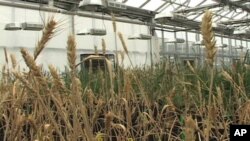Researchers are using the latest tools in genetics to help give farmers an edge in the race to feed the planet.
Food prices have been climbing in recent months because of bad weather in several major agricultural regions. Experts expect more extreme weather as the climate changes, threatening food supplies around the world. Farmers must also deal with the constant threats of insect pests, weeds, and diseases.
Using genetic markers, plant breeders like the University of Maryland's Jose Costa are improving crops with greater precision and accuracy than ever before.
Costa is working to protect farmers from a fungal disease called wheat scab that infected half the crop last year.
Poison grains
As he pours healthy and infected seeds into metal pans at his laboratory at the university's College Park campus, the effect of the disease is plain to see. The scabby seeds are white-ish, even pink in some spots, and they're ragged-looking next to the healthy wheat grains.
But beyond deforming the seeds, the fungus causes a much more serious problem.
"It causes vomiting in humans," Costa says. "So, we don't really want that in our bread or cookies."
But just like some people don't get sick as often as others, some varieties of wheat are less likely to get scab. Costa has one such variety from China growing in an incubator downstairs from his lab.
One in a thousand
The challenge, Costa says, is to mate a local wheat variety that produces a lot of grain but is susceptible to scab with the Chinese variety that is resistant to scab -- but doesn't produce as much.
"One or two plants in a thousand [will] carry the right combination of genes," he says.
Recent advances in genetics make the job of combining those genes easier.
Scientists are mapping the entire genetic code of wheat. They've already figured out the location of some of the key genes, including those for scab resistance and productivity. And to locate them quickly, they've found small stretches of DNA called markers.
Genetic landmarks
"Just like in real life you would use a landmark when you give directions, we use markers," says graduate student Lydia Cardwell.
Scientists mate the wheat plant from Maryland with the one from China by cross-pollinating them.
Until recently, finding that one-in-a-thousand offspring that is both resistant and productive meant growing lots of plants to maturity in big test plots.
Now, they grow young plants in a room-sized incubator. They extract genetic material from a small piece of leaf to look for the markers that will identify the scab resistant, productive offspring.
It takes far less space and it's far more accurate, Costa says. Out in the field, some plants just get lucky and escape infection even though they're susceptible to the disease.
"You don't know if they're resistant, or if they [just] escaped the disease," Costa says. "With markers, now we can tell if they do have the genes or not."
Tool for improving many crops
Plant breeders are using markers to improve many different crops.
"They're making combinations of genes possible that simply would have been impossible in the past," says Erik Legg, lead researcher with major global agriculture company Syngenta.
Syngenta is developing maize that tolerates both drought and flood. At least 15 genes are involved. Legg says planting enough maize to find that extremely unlikely combination of genes would be a challenge, to say the least.
"It's been estimated that stacking together 15 or more genes of interest through traditional breeding would take probably more arable land than is available on Earth," he says.
This advance in breeding comes at an important time. The UN Food and Agriculture Organization estimates that food production will need to increase by 70 percent by 2050 to meet the demands of a growing population. Meanwhile, climate change threatens food production in many parts of the world. Wheat scientist Jose Costa says breeders will need all the help they can get.
"Well, we don't know if it's going to be enough," he says. "It's the best we can do at this time. But it gives us a lot more weapons than what we had before."










